Various classifications have been devised to ascertain into which periods the northeast Argentinean cultures should be divided. The following periods are the most accepted presently: Early (500 B.C. – 600 A.D.), Middle (600 – 900 A.D.), Late (900 – 1480 A.D.), Incan (1480 – 1530 A.D.) and Hispano-indigenous (from 1530).
Early Cultures
To the west of the current province of Tucumán, the Taif culture arose (200 B.C – 800 A.D.). It was formed by groups who lived in individual, semi-circular houses made of adobe walls, reef roofs, and with completely open entrances. They were mainly farmers who cultivated maize and bred camelids as a source of food and wool, as well as using them for transport. They are considered to have been great masters of stone sculpture, of which their great monoliths especially stand out.
Some of these were decorated with bas-relief and feline shaped motifs. They also made masks representing human faces. Their pottery was monochromic and decorated with zoomorphic and anthropomorphic motifs and presumably played a part in religious rituals, as this type was scarce compared to domestic pottery which was much simpler and more abundant.
The Condorhuasi culture (200 B.C. – 300 A.D.) also had many great sculptors. This developed in the Hualfin Valley (Catamarca). It was essentially a society of shepherds,who mainly used llamas as sources of meat and wool, although they were also important in rituals and ceremonies. They excelled in pottery, which was very detailed and varied in shape. Among the most characteristic pieces are human figures which combined realistic and fantastic elements called «supplicants» because of their strange poses. They had cemeteries with different types of tombs: some were cylindrical and very deep, others had an oval or square design, and were made of stone slabs, which held one or more corpses, and there were also some made especially for children.
The last significant people of this period was the Cienaga culture (100 – 600 A.D.). Although they mainly lived in the current province of Catamarca, they spread from the Calchaqui Vally in the north to the province of San Juan in the south. They were great sketchers using the technique of incision to draw abstract and geometrical figures. In pottery, basketry, and in some petroglyphs they used lines decorated with geometric motifs. Nonetheless, the most relevant artistic expression of this nation was creating body painting, mainly done with the Urucú plant, which produces red pigments.
The middle stage
The only great culture to develop in this period was the La Aguada culture (600 – 900 A.D.) which developed in the province of Catamarca. Neverthess, it encompassed an extensive area, its influence even reached northern parts of Chile such as San Pedro de Atacama. They were led by an important political and religious elite, which ruled the different independent lordships that formed this culture. Each of these lordships came from a line of parentage beginning with a common ancestor. Although it is said that because of the large number of lordships that existed there was not a single authority, they still shared more or less the same system.
They were great farmers, and their main crops were beans, pumpkins, peanuts and corn. In order to water important crops they used complex hydraulic systems. At the same time they also collected the fruit of the chañar and carob tree. Craftspeople worked metal, especially bronze, with which they made figures, axe heads, and tweezers, among other objects. They also made vessels with geometric designs and anthropomorphic, feline, reptile, bird and amphibian motifs. Furthermore, they applied coloured pigments to some jars. In their funeral practices multiple burials stood out, in which several corpses were methodically buried at the same time.
The late period
The Santa María culture (1200 to 1470 A.D.) arose in the province of Catamarca. They reached a great level of socio-political complexity, which was centralised in a hereditary authority. There were also warriors and priests who held a high hierarchical position within society. Many villages with few houses were built and only a few sites attained an important level of urban development. Their houses were built mainly of stone and had two other rectangular rooms which converged into the main space which was a patio.
As in the other communities, they were also farmers who used terraced cultivation and watering systems which helped sustain a significant population and, at the same time, generated food surpluses. These were kept in subterranean storehouses to be used when there were food shortages. Furthermore, they were excellent cattle breeders who used different ecological niches to supply llamas with forage. The also used these animals for transporting goods when they undertook economic and cultural exchange with other nations.








 Muere Evita
Muere Evita